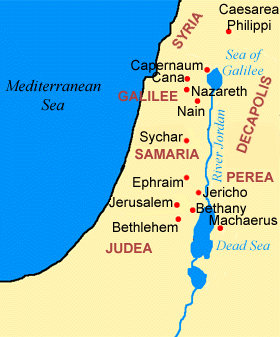

|
The four gospel books of the Bible - Matthew, Mark, Luke and John - tell the dramatic story of Jesus, the Son of God and our Savior. His birth, His parables and other teachings, His love for all God's people, His miracles, triumphs, disappointments, conflicts, prayers, arrest, trial, crucifixion, resurrection and ascension to heaven are all narrated in the gospels.


Jesus was very critical of the hypocrisy of the religious leaders of His time. He said they observed the letter of the Jewish law, but defiled its spirit by living lives of greed and sin. These religious leaders plotted to kill Jesus, and eventually forced the Roman governor, Pilate, to order His crucifixion on Friday, the eve of Passover. The gospels tell that Jesus arose from the dead on the following Sunday, and He remained on Earth another 40 days before ascending into heaven. Jesus, Himself, said He was the Son of God, the Christ, the Messiah awaited by the Jews. He said His death and resurrection were all part of God's mysterious plan for our salvation.

Saul, a fierce persecutor of Christians, had a dramatic conversion experience around the year 35 A.D. (Acts 9:1-19). He changed his name to Paul and became the first and most influential interpreter of the Christian message.
The gospel message was preserved in oral form for many years before being written down. Bible scholars believe the letters of Paul are the oldest books in the New Testament, written between 50 and 60 A.D. Mark was written around 70 A.D., about 40 years after Jesus was crucified. Matthew and Luke were written between 80 and 90 A.D. Finally, The Gospel of John appeared in its final form around 95 A.D. Bible Scholars believe Matthew and Luke incorporated much of the material from Mark into their gospels. They also included unique material of their own plus common material from a presumed source called "Q" (from the German, quelle, meaning "source"), which has not been preserved.
Because of their similarity, Matthew, Mark and Luke are called the synoptic gospels (from the Greek synopsis, meaning "a seeing together"). Most of the Bible Studies will be on a single book, but we are grouping the three synoptic gospels together because they have so much in common.
All four Gospels are anonymous in the sense that none mentions the author's name. The traditional names - Matthew, Mark, Luke and John - did not become associated with these writings until the second century. Whether or not these men were the actual authors is very controversial. For convenience, however, we will refer to Matthew, Mark, Luke and John as if they are the true authors.
The synoptic gospels read like a biography of Jesus, but that was not their original purpose. Neither were they written as history books or as books of a Christian Bible. Instead, they were first used in the early Christian churches as devotional materials, much like sermons. The human authors of these books selectively picked materials to include, rearranged it, and presented it in a way to suit their devotional purposes. Therefore we have to be content with gaps in our knowledge of Jesus' life and with some inconsistencies in names, places, times and other details of the events narrated in the gospels. However, we get a very similar "big picture" of Jesus' life and work from all four gospels, and we are fortunate to have these four "windows" to see four views of the central events of Christianity.
We also supply answers for some of the questions. However, for maximum personal benefit, you should answer all the questions yourself before looking at our answers. Our answers are given from a mainstream Christian and historical viewpoint. We use the best reference materials available to present the Bible as it was understood by the original audience in Biblical times. But God calls different people in different ways, and there is no single "right" answer for many of the questions; your answers may well be different from ours.
The Bible Studies are nonsectarian, and are suitable for use by all Christians. The vast majority of the gospel passages are interpreted the same way by all mainstream Christian denominations. A few passages are controversial, and we will sometimes point out and explain the denominational differences.
Most of the Bible studies in this series will proceed from beginning to end of the Bible book in an orderly manner. In contrast, the study of Matthew, Mark and Luke will seem very fragmented. We have used the arrangement of verses suggested by Dr. Burton Throckmorton in his book, Gospel Parallels, A Synopsis of the First Three Gospels. Every verse is included, but, as much as possible, corresponding sections of the three gospels are grouped together and arranged in chronological order. This will somewhat disturb the flow of the individual gospels, but it will hopefully provide the clearest overall picture of Jesus' life, works, death, resurrection and His messages to us.